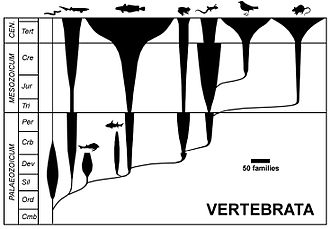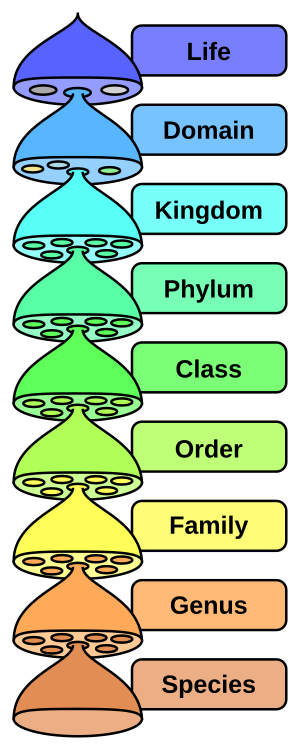Taxonomy (biology)
(Redirected from Biological classification)
Taxonomy (biology) is the science of defining and naming groups of biological organisms based on shared characteristics. Organisms are grouped into taxa (singular: taxon) and these groups are given a taxonomic rank. The principal ranks in modern biological classification are domain, kingdom, phylum, class, order, family, genus, and species.
History
The practice of taxonomy dates back to ancient times, but the modern system of taxonomy was developed by Carl Linnaeus in the 18th century. Linnaeus introduced the system of binomial nomenclature, where each species is given a two-part name: the genus name and the species name.
Principles of Taxonomy
Taxonomy is based on several key principles:
- Hierarchical classification: Organisms are classified into a hierarchy of groups and subgroups.
- Binomial nomenclature: Each species is given a unique two-part name.
- Phylogenetics: The evolutionary relationships between organisms are considered in their classification.
Taxonomic Ranks
The main taxonomic ranks are:
Modern Taxonomy
Modern taxonomy uses a variety of data sources, including morphology, genetics, and biochemistry, to classify organisms. The advent of molecular phylogenetics has revolutionized the field, allowing for more precise classifications based on genetic information.
Importance of Taxonomy
Taxonomy is crucial for the organization of biological knowledge. It allows scientists to communicate about organisms using a standardized system and provides insights into the evolutionary relationships between different species.
Related Pages
- Binomial nomenclature
- Phylogenetics
- Carl Linnaeus
- Molecular phylogenetics
- Hierarchical classification
Transform your life with W8MD's budget GLP-1 injections from $125.
W8MD offers a medical weight loss program to lose weight in Philadelphia. Our physician-supervised medical weight loss provides:
- Most insurances accepted or discounted self-pay rates. We will obtain insurance prior authorizations if needed.
- Generic GLP1 weight loss injections from $125 for the starting dose.
- Also offer prescription weight loss medications including Phentermine, Qsymia, Diethylpropion, Contrave etc.
NYC weight loss doctor appointments
Start your NYC weight loss journey today at our NYC medical weight loss and Philadelphia medical weight loss clinics.
- Call 718-946-5500 to lose weight in NYC or for medical weight loss in Philadelphia 215-676-2334.
- Tags:NYC medical weight loss, Philadelphia lose weight Zepbound NYC, Budget GLP1 weight loss injections, Wegovy Philadelphia, Wegovy NYC, Philadelphia medical weight loss, Brookly weight loss and Wegovy NYC
|
WikiMD's Wellness Encyclopedia |
| Let Food Be Thy Medicine Medicine Thy Food - Hippocrates |
Medical Disclaimer: WikiMD is not a substitute for professional medical advice. The information on WikiMD is provided as an information resource only, may be incorrect, outdated or misleading, and is not to be used or relied on for any diagnostic or treatment purposes. Please consult your health care provider before making any healthcare decisions or for guidance about a specific medical condition. WikiMD expressly disclaims responsibility, and shall have no liability, for any damages, loss, injury, or liability whatsoever suffered as a result of your reliance on the information contained in this site. By visiting this site you agree to the foregoing terms and conditions, which may from time to time be changed or supplemented by WikiMD. If you do not agree to the foregoing terms and conditions, you should not enter or use this site. See full disclaimer.
Credits:Most images are courtesy of Wikimedia commons, and templates, categories Wikipedia, licensed under CC BY SA or similar.
Translate this page: - East Asian
中文,
日本,
한국어,
South Asian
हिन्दी,
தமிழ்,
తెలుగు,
Urdu,
ಕನ್ನಡ,
Southeast Asian
Indonesian,
Vietnamese,
Thai,
မြန်မာဘာသာ,
বাংলা
European
español,
Deutsch,
français,
Greek,
português do Brasil,
polski,
română,
русский,
Nederlands,
norsk,
svenska,
suomi,
Italian
Middle Eastern & African
عربى,
Turkish,
Persian,
Hebrew,
Afrikaans,
isiZulu,
Kiswahili,
Other
Bulgarian,
Hungarian,
Czech,
Swedish,
മലയാളം,
मराठी,
ਪੰਜਾਬੀ,
ગુજરાતી,
Portuguese,
Ukrainian
Contributors: Prab R. Tumpati, MD






